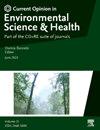Environmental DNA signatures as a tool to trace the groundwater contamination mechanisms and its associated biodiversity; Applications, limitations and future directions
IF 6.6
Q1 ENVIRONMENTAL SCIENCES
Current Opinion in Environmental Science and Health
Pub Date : 2025-04-11
DOI:10.1016/j.coesh.2025.100622
引用次数: 0
Abstract
Environmental DNA (eDNA) signatures are indicative of various conditions in nature. Groundwater systems are vital for diverse ecosystems, presenting unique challenges and opportunities for environmental DNA (eDNA) applications. Ecosystem monitoring, conservation management, and biodiversity evaluation in groundwater-dependent ecosystems (GDEs) rely heavily on eDNA. Groundwater eDNA sources, including plant and animal life, are discussed in this article, along with their applications in determining salinity, water quality, and ecosystem dynamics. In groundwater ecosystems, eDNA is invaluable in detecting species that are otherwise difficult to monitor due to the subterranean nature of the habitat. Interpretation limitations (e.g. lack of reference databases) and technical challenges (e.g. contamination, extraction and detection techniques) are key concerns in GDE. The review also suggests numerous future possibilities, such as integrating eDNA with other techniques like aquifer matrix, hydrogeochemistry, isotopes, and hydrological modeling to improve our understanding of groundwater ecosystems.

环境DNA特征作为追踪地下水污染机制及其相关生物多样性的工具应用、限制和未来方向
环境DNA (eDNA)特征是自然界各种条件的指示。地下水系统对多种生态系统至关重要,为环境DNA (eDNA)的应用带来了独特的挑战和机遇。地下水依赖生态系统(GDEs)的生态系统监测、保护管理和生物多样性评价严重依赖于eDNA。本文讨论了地下水eDNA来源,包括植物和动物生命,以及它们在确定盐度、水质和生态系统动力学方面的应用。在地下水生态系统中,eDNA在探测由于地下生境而难以监测的物种方面是无价的。解释限制(如缺乏参考数据库)和技术挑战(如污染、提取和检测技术)是全球环境评估的主要关注点。该综述还提出了许多未来的可能性,例如将eDNA与其他技术结合起来,如含水层基质、水文地球化学、同位素和水文建模,以提高我们对地下水生态系统的理解。
本文章由计算机程序翻译,如有差异,请以英文原文为准。
求助全文
约1分钟内获得全文
求助全文
来源期刊

Current Opinion in Environmental Science and Health
Medicine-Public Health, Environmental and Occupational Health
CiteScore
14.90
自引率
0.00%
发文量
92
审稿时长
114 days
 求助内容:
求助内容: 应助结果提醒方式:
应助结果提醒方式:


